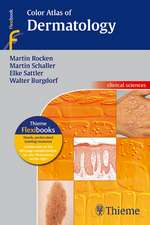Vitiligo
Editat de Mauro Picardo, Alain Taïeben Limba Engleză Paperback – 13 dec 2014
| Toate formatele și edițiile | Preț | Express |
|---|---|---|
| Paperback (1) | 1426.65 lei 38-44 zile | |
| Springer Berlin, Heidelberg – 13 dec 2014 | 1426.65 lei 38-44 zile | |
| Hardback (1) | 917.72 lei 38-44 zile | |
| Springer International Publishing – 12 aug 2019 | 917.72 lei 38-44 zile |
Preț: 1426.65 lei
Preț vechi: 1501.73 lei
-5% Nou
Puncte Express: 2140
Preț estimativ în valută:
273.08€ • 296.72$ • 229.53£
273.08€ • 296.72$ • 229.53£
Carte tipărită la comandă
Livrare economică 17-23 aprilie
Preluare comenzi: 021 569.72.76
Specificații
ISBN-13: 9783642422744
ISBN-10: 3642422748
Pagini: 504
Ilustrații: XVII, 483 p.
Dimensiuni: 193 x 260 x 26 mm
Ediția:2010
Editura: Springer Berlin, Heidelberg
Colecția Springer
Locul publicării:Berlin, Heidelberg, Germany
ISBN-10: 3642422748
Pagini: 504
Ilustrații: XVII, 483 p.
Dimensiuni: 193 x 260 x 26 mm
Ediția:2010
Editura: Springer Berlin, Heidelberg
Colecția Springer
Locul publicării:Berlin, Heidelberg, Germany
Public țintă
Professional/practitionerCuprins
Defining the Disease.- Historical Aspects.- Epidemiology, Definitions and Classification.- Histopathology.- Generalized Vitiligo.- Segmental Vitiligo.- Vitiligo Universalis.- Mucosal Vitiligo.- Halo Nevi and Vitiligo.- Hair Involvement in Vitiligo.- Non-Skin Melanocytes in Vitiligo.- Autoimmune/Inflammatory and Other Diseases Associated with Vitiligo.- Vitiligo and Immunodeficiencies.- Inflammatory Vitiligo.- Rare Inherited Diseases and Vitiligo.- Vitiligo in Childhood.- Late-Onset Vitiligo.- Evaluation, Assessment and Scoring.- Quality of Life.- Natural History and Prognosis.- Defining the Disease: Editor's Synthesis.- Understanding the Disease.- Pathophysiology Overview.- Genetics.- Environmental Factors.- In Vivo Data.- Animal Models.- In Vitro Approaches.- Oxidative Stress.- Immune/Inflammatory Aspects.- Cytokines and Growth Factors.- Proopiomelanocortin and Related Hormones.- Other Hypotheses.- Particular Clinical Characteristics of Segmental Vitiligo.- The Concept of Mosaicism Applied to SV.- The Neurogenic Hypothesis in Segmental Vitiligo.- Segmental Vitiligo: A Model for Understanding the Recapitulation of Repigmentation.- Editor’s Synthesis.- Therapy.- Management Overview.- Topical Corticosteroids.- Calcineurin Inhibitors.- Vitamin D Analogues.- PUVA and Related Treatments.- UVB Total Body and Targeted Phototherapies.- Vitamins and Antioxidants: Topical and Systemic.- Corticosteroid Minipulses.- Other Immunosuppressive Regimen.- Empirical, Traditional, and Alternative Treatments.- Background and Techniques.- The Outcomes: Lessons About Surgical Therapy for Vitiligo in the Past Two Decades.- Combined Therapies for Vitiligo.- Camouflage.- Photoprotection Issues.- Depigmenting Agents.- Therapy Adapted for Age, Gender, and Specific Locations.- Psychological Interventions.- The Patient Perspective.- Evidence-Based Medicine Perspective.- Editor's Synthesis and Perspectives.
Caracteristici
First highly up-to-date book showing new therapies for vitiligo Lavishly illustrated covering all aspects Overview on the classification, pathogenesis, methods of diagnosis and treatment of vitiligo All therapy recommendations based on new evidence-based guidelines. Includes case studies with illustrations before and after the treatment demonstrating treatment success Designed for beginners in the field and experts Includes supplementary material: sn.pub/extras
Notă biografică
Professor Mauro Picardo graduated in Rome at “La Sapienza” University, his main topics of interest are skin biochemistry, free radical mediated damage of the skin, mechanism of control of skin pigmentation, and pigmentary disorders. As Director of the Integrated Center of Metabolomic Research (CIRM) at the San Gallicano Institute, he coordinates lipidomic studies on acne and related disorders (seborrheic dermatitis, rosacea) in sebum and blood samples. The team is specialised in vitiligo and in particular in the study of the biological and molecular mechanisms involved in pigmentation with the aim of finding new preventative and therapeutic treatments. Dr Picardo has served in the Board of national and International scientific societies as well as being President of the ESPCR. He chairs the Vitiligo European Task Force and the Pigmentary disorders group of the EADV in collaboration with Dr. Alain Taieb. Professor Picardo has organized several national and international conferences (such as the Vitiligo International Symposium held in Rome in Dec 2016) and is member of the Editorial Board of many dermatological and biochemical journals including Pigment Cell and Melanoma Research and Experimental Dermatology. He is author of more than 300 publications in peer-reviewed journals and more than 30 chapters in different books, most of which are dedicated to pigmentation, focusing on both the biological and clinical approaches.
Alain Taïeb is professor emeritus of Dermatology at Bordeaux University. He established the National Reference Centre for Rare Skin Disorders in 2005. He was until recently Director of INSERM 1035 research lab “Biotherapy of genetic diseases, inflammatory disorders and cancer” (BMGIC). He set up the European Task Force on Atopic Dermatitis in 1990, and the Vitiligo European Task Force in 2003, which are the current official ad hoc tasks forces of the EADV. He has authored more than 600 articles in peer-reviewed journals and more than 60 chapters in multiauthored books. In addition, he published “History of Atopic Dermatitis” with Dr Wallach and Tilles, in 2004, and two textbooks “Neonatal Dermatology” with Drs Enjolras, Wallach and Vabres (2009) and “Vitiligo” with Dr Picardo (2010- second edition 2019). His major topics of interest are pediatric dermatology, genodermatoses, atopic dermatitis, vitiligo and pigment cell disorders. He has received several awards and distinctions in particular from the Society for Pediatric Dermatology, the European Society of Pediatric Dermatology, the International League of Dermatological Societies, the American Skin Association, and the European Society for Pigment Cell Research. H factor 59 (WoS). Dr Taïeb is currently President of the International Society of Atopic Dermatitis.
Alain Taïeb is professor emeritus of Dermatology at Bordeaux University. He established the National Reference Centre for Rare Skin Disorders in 2005. He was until recently Director of INSERM 1035 research lab “Biotherapy of genetic diseases, inflammatory disorders and cancer” (BMGIC). He set up the European Task Force on Atopic Dermatitis in 1990, and the Vitiligo European Task Force in 2003, which are the current official ad hoc tasks forces of the EADV. He has authored more than 600 articles in peer-reviewed journals and more than 60 chapters in multiauthored books. In addition, he published “History of Atopic Dermatitis” with Dr Wallach and Tilles, in 2004, and two textbooks “Neonatal Dermatology” with Drs Enjolras, Wallach and Vabres (2009) and “Vitiligo” with Dr Picardo (2010- second edition 2019). His major topics of interest are pediatric dermatology, genodermatoses, atopic dermatitis, vitiligo and pigment cell disorders. He has received several awards and distinctions in particular from the Society for Pediatric Dermatology, the European Society of Pediatric Dermatology, the International League of Dermatological Societies, the American Skin Association, and the European Society for Pigment Cell Research. H factor 59 (WoS). Dr Taïeb is currently President of the International Society of Atopic Dermatitis.
Textul de pe ultima copertă
Since the first edition of this book was published, new knowledge has been gained on Vitiligo. This widely revised and updated second edition, written by worldwide experts in the field, fully reflects this progress. The apparently, simple and poorly symptomatic presentation of the disease has been a strong disadvantage to its study, as compared to other common chronic skin disorders such as psoriasis and atopic dermatitis. A good skin-based angle of attack is also lacking because generalized Vitiligo is clearly epitomizing the view of skin diseases as simple targets of a systemic unknown dysregulation (diathesis). This view has mostly restricted Vitiligo to the manifestation of an auto-immune diathesis and skin events, which are easily detected using skin biospies in most other situations, have not been precisely recorded, with the argument that a clinical diagnosis was sufficient for the management of the patient with Vitiligo. This richly illustrated second edition reflectsthe constant international effort to share the information gathered about this disorder at the clinical, pathophysiological and therapeutic levels. Its aim still being to bridge current knowledge at the clinical and investigative level, to point to the many unsolved issues, and to delineate future priorities for research.











